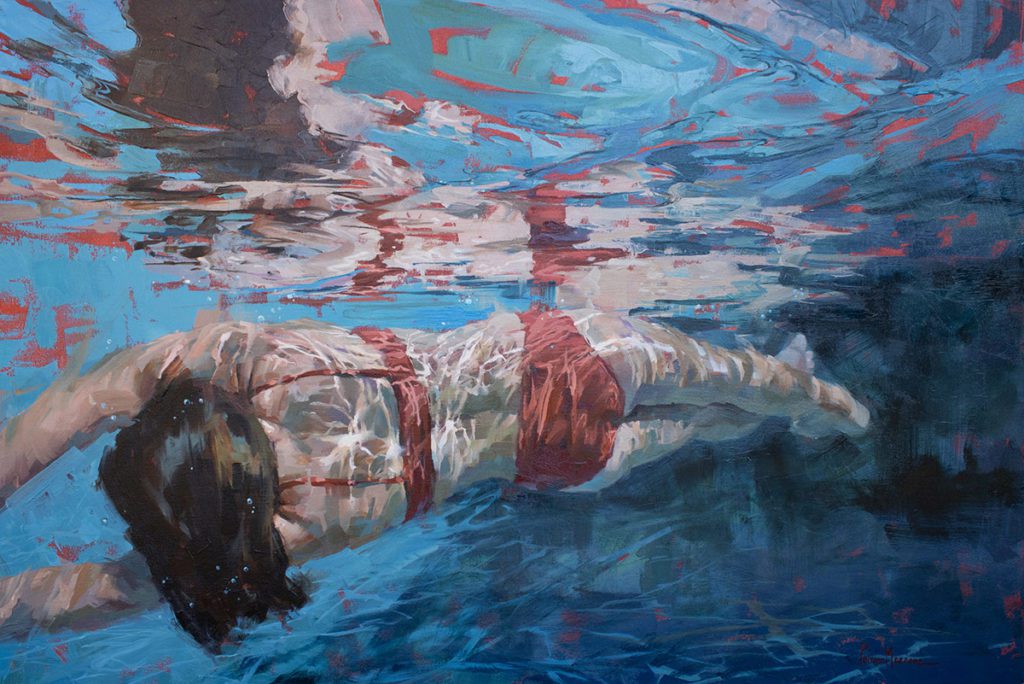“Fractured Light” opens at the Paul Dietrich Gallery
CambridgeSeven News - March 02, 2020

Our Paul Dietrich Gallery curator, Kwesi Budu-Arthur, recently caught up with Artist Michele Poirier-Mozzone to learn more about her influences and her process. Excerpts of our interview with Michele are below. The Spring show features her underwater paintings from her series, Fractured Light. It is now on view through May 29, 2020; please note, however, that due to recent public health concerns, the March 19 opening reception has been postponed. We will post a new date once it is rescheduled.
Kwesi Budu-Arthur (KBA): What type of artist do you consider yourself?
Michele Poirier-Mozzone (MPM): Contemporary impressionist
(KBA): Are you formally trained as an artist?
(MPM): Yes, I have a Bachelor of Fine Arts degree from Emmanuel College in Boston
(KBA): Is there an exhibition, book or image that you remember for the first time really responding to?
(MPM): I saw a watercolor exhibit of works by John Singer Sargent and Winslow Homer at the MFA in the 1980s and was literally brought to tears – could not hold it back. This had never happened to me before and I was thoroughly embarrassed!
(KBA): If you could go back ten years, what advice would you give yourself?
(MPM): You are capable of much more than you think, so don’t hesitate to put yourself out there. Ten years ago I had a difficult revelation: my dad passed away suddenly and I realized life wasn’t going to wait for me to give my all to painting. I had delayed focusing on my passion because I was busy raising a family, but mainly because it is frightening to commit fully and put my work up for all to see and judge. I decided it was time to focus and try. These last ten years have been the most fulfilling, overwhelming artistic ride I could ever have imagined and I am gratefully looking forward to where it may lead me next.
(KBA): Tell us about your creative process.
(MPM): My process begins with video footage I take with a GoPro camera in our backyard pool. I then search frame-by-frame for an image that strikes me as a potential painting. Composition is a key factor in a successful painting and I spend a good portion of time planning, cropping and doing thumbnail studies for value and placement. I think about only including what is important in a painting – the essence. Thinking of the figure as another compositional element allows me to treat it less preciously and edit components for the benefit of the overall painting. The palette I will use depends on the mood I am trying to create. I generally start with a colorful underpainting. There is no formula for my underpainting color choices –other than I try to select colors to enhance the oil paint or pastel that will be applied on top. Sometimes I use a vibrant complementary underpainting, other times something dark or similar in color to the finished piece. Lately, however, oranges and reds have presided. I find the contrast with the inevitable turquoise and blues of the water to be just the pop many pieces need.
Once dry, passages of soft pastel are built, while leaving bits of underpainting to peak through adding interest, texture and dimension. If painting in oil, I begin with a palette knife and generous swaths of color, but again, leaving bits of underpaitning showing through. My reference photos are predominantly blue so I try to push the palette away from the familiar and stretch its possibilities. Paying attention to how colors and shapes are altered in the reflection of an object is important. Bubbles, sparkles and highlights are added last – this is when the painting comes to life. The closer a painting is to completion, the more my work becomes intuitive and less reliant on the original reference. Although each piece starts with preparatory thumbnail sketches, I am always surprised by the finished product. They each take on a unique personality and story despite my planning.
(KBA): Has your style changed over the years?
(MPM): I have been exploring this Fractured Light series of the figure in water for 9 years now. Pastel was my medium of choice for the first 7 of those years. When I look back at the early paintings in this series, I can definitely feel the excitement I had about my new subject matter and the cautiousness with which I was applying pastel to paper. As with any series of work, one becomes more confident with repetition and exploration of a certain subject and medium and I think my pastels reflect that today.
Three years ago I began trying to translate this subject into oil. It was frustrating at first as I grappled with how to achieve the vibrancy and watery effects that I could get with pastel. My initial oil paintings lacked the confidence of stroke and vitality of the pastels. Over time, I have learned that an underpainting and an initial thick application of paint with a palette knife gives my oil paintings the texture and boldness I am looking for and they now fit nicely alongside the pastels in this series. Oil painting has made me more aware of lovely brushstrokes, delicious surface texture and the delicate balance of letting the paint do its thing while still controlling it.